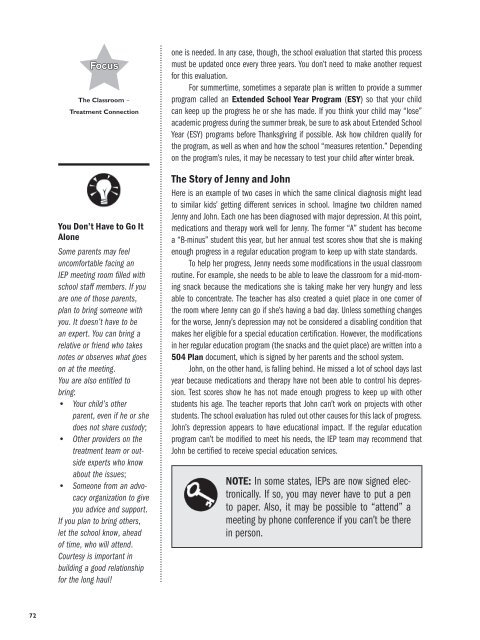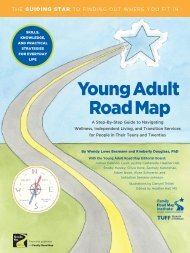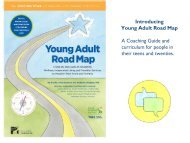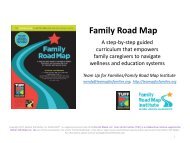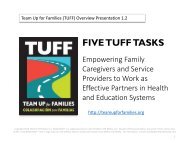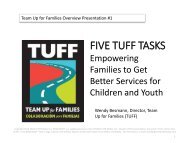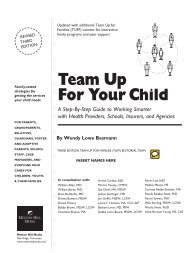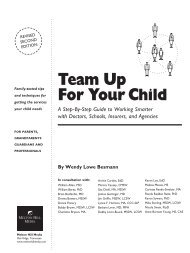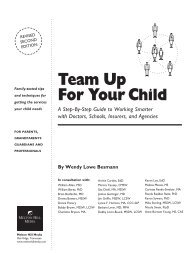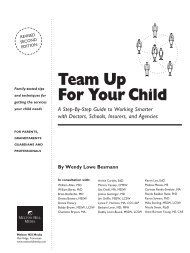Family Road Map Guide
Create successful ePaper yourself
Turn your PDF publications into a flip-book with our unique Google optimized e-Paper software.
Focus<br />
The Classroom –<br />
Treatment Connection<br />
You Don’t Have to Go It<br />
Alone<br />
Some parents may feel<br />
uncomfortable facing an<br />
IEP meeting room filled with<br />
school staff members. If you<br />
are one of those parents,<br />
plan to bring someone with<br />
you. It doesn’t have to be<br />
an expert. You can bring a<br />
relative or friend who takes<br />
notes or observes what goes<br />
on at the meeting.<br />
You are also entitled to<br />
bring:<br />
• Your child’s other<br />
parent, even if he or she<br />
does not share custody;<br />
• Other providers on the<br />
treatment team or outside<br />
experts who know<br />
about the issues;<br />
• Someone from an advocacy<br />
organization to give<br />
you advice and support.<br />
If you plan to bring others,<br />
let the school know, ahead<br />
of time, who will attend.<br />
Courtesy is important in<br />
building a good relationship<br />
for the long haul!<br />
one is needed. In any case, though, the school evaluation that started this process<br />
must be updated once every three years. You don’t need to make another request<br />
for this evaluation.<br />
For summertime, sometimes a separate plan is written to provide a summer<br />
program called an Extended School Year Program (ESY) so that your child<br />
can keep up the progress he or she has made. If you think your child may “lose”<br />
academic progress during the summer break, be sure to ask about Extended School<br />
Year (ESY) programs before Thanksgiving if possible. Ask how children qualify for<br />
the program, as well as when and how the school “measures retention.” Depending<br />
on the program’s rules, it may be necessary to test your child after winter break.<br />
The Story of Jenny and John<br />
Here is an example of two cases in which the same clinical diagnosis might lead<br />
to similar kids’ getting different services in school. Imagine two children named<br />
Jenny and John. Each one has been diagnosed with major depression. At this point,<br />
medications and therapy work well for Jenny. The former “A” student has become<br />
a “B-minus” student this year, but her annual test scores show that she is making<br />
enough progress in a regular education program to keep up with state standards.<br />
To help her progress, Jenny needs some modifications in the usual classroom<br />
routine. For example, she needs to be able to leave the classroom for a mid-morning<br />
snack because the medications she is taking make her very hungry and less<br />
able to concentrate. The teacher has also created a quiet place in one corner of<br />
the room where Jenny can go if she’s having a bad day. Unless something changes<br />
for the worse, Jenny’s depression may not be considered a disabling condition that<br />
makes her eligible for a special education certification. However, the modifications<br />
in her regular education program (the snacks and the quiet place) are written into a<br />
504 Plan document, which is signed by her parents and the school system.<br />
John, on the other hand, is falling behind. He missed a lot of school days last<br />
year because medications and therapy have not been able to control his depression.<br />
Test scores show he has not made enough progress to keep up with other<br />
students his age. The teacher reports that John can’t work on projects with other<br />
students. The school evaluation has ruled out other causes for this lack of progress.<br />
John’s depression appears to have educational impact. If the regular education<br />
program can’t be modified to meet his needs, the IEP team may recommend that<br />
John be certified to receive special education services.<br />
NOTE: In some states, IEPs are now signed electronically.<br />
If so, you may never have to put a pen<br />
to paper. Also, it may be possible to “attend” a<br />
meeting by phone conference if you can’t be there<br />
in person.<br />
72


